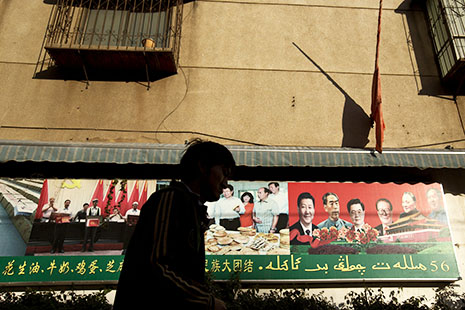LAST WEEK China witnessed one of the ugliest acts of interethnic violence in years. Yet the Chinese government used all its powers to make sure the story was more or less dead within forty-eight hours. What does Chinese president Xi Jinping fear? Judging from the government’s response to the incident, it fears its citizens more than any minority separatists or terrorists.
On 1 March a group of black-clad assailants armed with large-blade knives hacked their way wildly through a crowded Kunming railway station, leaving thirty-three dead and more than 140 injured. Live reports and macabre photos spread quickly on Chinese social media. In shock, the nation tried to make sense of a wanton act that some dubbed “China’s 9/11.”
Xi immediately ordered “relevant parties to firmly suppress terrorists’ rampant momentum, be fully aware of the grave and complex anti-terrorism situation and strengthen bottomline thinking.” Security chief Meng Jianzhu and public security minister Guo Shengkun were dispatched to supervise the investigation and a massive manhunt for the five perpetrators who had reportedly escaped.
The following day, local authorities in Kunming claimed that “evidence at the crime scene showed that the Kunming Railway Station terrorist attack was carried out by Xinjiang separatist forces,” but reassured its edgy citizenry that “order has been restored in Kunming.” The word “Uyghur” was on everyone’s lips, with public blame focused squarely on this Muslim minority group who live almost exclusively in western China’s Xinjiang Uyghur Autonomous Region, or XUAR.
But the central government immediately dismissed any ethnic or religious angle, with officials and delegates arriving in Beijing for the annual Chinese People’s Political Consultative Conference instead fingering unnamed “terrorists.” “The well-planned attack was not an issue of ethnics or religion [sic],” the official Xinhua News Agency quoted one delegate as saying, “it was an issue of terrorism with links to the terrorist forces out of the country.”
Meanwhile, state censors worked overtime deleting social media posts, including images of dead assailants, grotesquely mutilated bodies and recovered t-shirts and flags with Arabic script and the star and crescent symbol of East Turkestan, the independent state that some Uyghurs and their supporters seek to create in Xinjiang.
With many Uyghurs chafing under the state’s integrationist policies and waves of Han migration, Xinjiang has long been troubled by interethnic violence. Local security officials claim that “more than 190 terrorist attacks” occurred in the restive province in 2012 alone. Several years earlier, Uyghur residents of the provincial capital Ürümqi unleashed a deadly pogrom on Han residents that left nearly 200 dead, according to official figures.
The attack at Kunming was different, marking a significant seepage of interethnic violence outside the XUAR. The Uyghur-driven car that killed five when it exploded in Tiananmen Square last October appears to have been an individual act of vengeance. The Kunming attack, while crude in weaponry, exhibited a degree of group planning and coordination, and stoked mass hysteria because of its scale and brutality. In the past, Uyghur indignation was chiefly directed at symbols of the state (police stations, government buildings and security forces); here, ordinary citizens in the distant and idyllic capital of Yunnan province were targeted.
In the hours that followed, many Chinese citizens called for a calm and considered government response. Yet, in the absence of reliable information, racist invective also flew back and forth across social media. Take the following exchange, which began (in Chinese): “If you want your city to be safe, then drive out all the Xinjiang people. Businesses shouldn’t employ them; we shouldn’t buy their products and services; we should stop patronising their restaurants; stop buying their products; stop selling their cars petrol… completely isolate them…” To which came the following reply (in Uyghur): “You shouldn’t talk like that, infidel. It is only a matter of time before Allah, his army, and we wipe you away. You filthy, polytheist, infidel Khitay.” Khitay is a derogatory term for the Han people.
Fearing retaliatory attacks and possible ethnic contagion, the government sought to end speculation and close down discussion. Late on the Monday evening after the attack, Xinhua issued a terse statement claiming “success” in “smashing the case” after a mere forty hours of investigation.
Despite earlier reports of ten attackers, authorities now insisted only eight were involved: four shot dead, one caught at the scene and three others captured later by police. They provided few details – no photos or confessions, nor the identities of the attackers and victims – stating only that the plot was masterminded by someone named Abdurehim Kurban.
Within hours, the State Council Information Office issued a directive to all news units: “Media that report on the knife attack incident that occurred March 1 at the Kunming Railway Station must strictly adhere to Xinhua News Agency wire copy or information provided by local authorities. Do not treat the story with large headlines; do not publish grisly photos. Please respond to confirm that you have received this message. Thank you.”
Sensing a cover-up, Chinese netizens continued to discuss the attacks online. In response, the state arrested forty-five people for spreading rumours online and “provoking panic,” and issued a public warning to high-profile microbloggers who were “ignoring facts” and “mistaking the black for the white.”
THE EVENTS of the past ten days highlight the tricky spot Xi Jinping finds himself in. He can’t afford to look soft on “terrorism,” but he doesn’t want discussion of this incendiary ethnic incident to derail the main themes of his “China dream.” There are at least three reasons why the government has sought to curtail further public discussion.
First, China’s top legislative body, the National People’s Congress, opened in Beijing on 5 March. Here, delegates are discussing the government’s work plan as well as Xi’s economic reform agenda outlined during the Third Plenum in October. The party leadership wants the nation and its media focused squarely on Xi’s blueprint, with reform rather than terror the key buzzword of this annual gathering. “Deepening reform is the most important theme of the Chinese society [sic],” spokesperson Fu Ying said at the opening press conference of 4 March.
Second, the Chinese government fears that open discussion of the Kunming attacks could further inflame the racist sentiments that run deep in certain segments of Chinese society. Ask your ordinary resident of Beijing or Kunming what they think of Uyghurs, and you are likely to get a string of pejorative epithets, including “sinister thieves” and “knife-wielding swindlers.”
Any majority backlash would conflict with the state’s myth of “harmonious ethnic relations” and undermine the party’s authority. When Han residents of Ürümqi feared for their safety in the wake of the 2009 riots, they forced the dismissal of long-time Xinjiang party secretary Wang Lequan. Ultimately, China’s leaders fear Han discontent more than any minority resistance.
Third, the Kunming attacks highlight not only security lapses but also more fundamental problems with China’s ethnic policies. The ethnic riots in Lhasa and Ürümqi in 2008–09 caused many Chinese to question the effectiveness of the current approach. Some now call for greater autonomy for the Uyghurs and other embattled ethnic minorities; more believe that the government’s preferential minority policies (extra children, added exam points and judicial leniency) have emboldened minorities like the Uyghurs, and want all barriers to “ethnic fusion” removed.
In sum, the government’s response fits a predictable pattern: control the flow of information; redirect public ire to external players (this time CNN and other foreign coverage); and further tighten the party’s grip over society. As a result, China spends more on domestic security than external defence, with much of this money finding its way into frontier regions like the XUAR, whose internal security budget has jumped to US$1 billion since 2009. And with ethnic violence spilling over into other regions, we can expect tighter security across major inland and coastal cities and even more intense surveillance of the small and beleaguered Uyghur communities living outside the XUAR. A new anti-terror law is also on the legislative agenda.
The China dream, Xi Jinping and his propaganda organs continue to stress, is the collective dream of all China’s ethnic groups. “In making this dream a reality,” the head of the State Ethnic Affairs Commission is quoted as saying, “we must go a step further in our ethnic work and better muster and solidify the fifty-six ethnic groups… [O]ne must draw together and unify dreams in order to realise the China dream.”
Yet the Chinese leadership’s failure to permit an open and robust discussion of the causes and consequences of the Kunming attacks will do the opposite. It will ensure not only separate dreams but also separate beds for China’s Han and Uyghur communities in the aftermath of this tragic event. •




